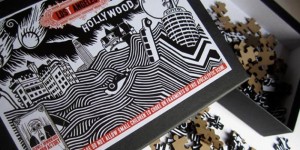TRENDSPOTTING: Alt-rock's middle age
by Richard Trapunski
March 25, 2013
“To me this award means a lot because it shows that the human element of music is what’s important. Singing into a microphone and learning to play an instrument and learning to do your craft, that’s the most important thing for people to do. It’s not about being perfect, it’s not about sounding absolutely correct, it’s not about what goes on in a computer. It’s about what goes on in here [your heart] and what goes on in here [your head].”
Those words, spoken by Dave Grohl while accepting a Grammy for Best Rock Performance for the Foo Fighters in 2012, transformed the erstwhile “nicest guy in rock” into Public Enemy no. 1 for a number of contemporary music fans. At the time, it seemed like a dig at the burgeoning EDM movement that was just reaching its festival-filling apex, a “get off my lawn” moment from one of the last remaining arena rockers. It’s not hard to see why it ruffled some feathers: suddenly, the former drummer for Nirvana, the band that symbolically nailed the coffin of hair metal excess, was the defender of the long-haired-white-guys-with-guitars status quo.
In a Trendspotting column last August, I asked if there was room for rap’s middle age. There are a number of reasons that question is relevant to hip-hop where it isn’t to, say, classic rock. While dinosaurs like Roger Waters and the Who fill stadiums playing albums nearly four decades old, hip-hop is still considered a “young man’s game,” even as the genre’s originators have been similarly canonized. But the question is certainly applicable to alt-rockers like Dave Grohl. When a movement that established itself as a rejection or “alternative” to the mainstream becomes the mainstream, how do its former stalwarts stay in the game without abandoning the values that got them there?
That’s been a question not only for Grohl, who basically hasn’t stopped talking since the Grammys, but for a group of his left-standing alt-rock peers who have recently stepped away from their still-popular primary projects to try something a little different. In the last month, Trent Reznor, Thom Yorke, and Thurston Moore have all released debut albums from new side projects. Each, whether explicitly or implicitly, has had to address those Gen X crises.
Unlike them, Grohl seems completely at home playing the elder statesman. Taking a break from Foo Fighters, the guitarist/drummer recently made his debut as a director. His documentary, Sound City, expands upon that “human element” he says is missing from a lot of music today. Eulogizing the eponymous Los Angeles recording studio, shuttered in 2009, the film gathers some of rock’s most entrenched stars–Stevie Nicks, Paul McCartney and, uh, Rick Springfield, to name a few–to expound upon the virtue of analogue recording and the ineffable “magic” that happens when recording in the same room as other musicians.
The accompanying soundtrack, Real to Reel, recorded on Sound City’s rescued soundboard, which Grohl installed at his own studio, gathers some of those names to jam. That creates some admittedly cool mindfuck collaborations, like Slipknot’s Corey Taylor and Cheap Trick’s Rick Nielson, or the much-celebrated Sirvana, but it also implicitly inserts Grohl into the pantheon of long-ago established AOR standards. It feels a lot like someone’s uncle handing down a vinyl copy of Led Zeppelin IV as an introduction to “real music.”
To be fair, Grohl’s position is a bit more nuanced than that. In his SXSW keynote speech (there’s that elder statesmen role again), he presented a new mantra, “the musician comes first,” finding worth in “the simple reward of just playing music,” essentially doing it on your own terms. Re-asserting his punk bona fides, Grohl praises DIY ethic and the worth of establishing your voice away from “corrupting” outside forces. But through his millionaire tunnel-vision, Grohl misses the fact that the computers that he thinks are removing the magic “human element” are actually music’s biggest recent democratizer. Grohl and his rock-star pals can record on analogue because Grohl has the money to afford that soundboard. For a kid starting in his bedroom, GarageBand can be the key to DIY. Does that make it any less authentic?
While gazing backwards, Grohl fails to see that punk rock doesn’t mean the same thing it once did. Then again, if fellow grunge survivor John Roderick is to be believed, it was always meaningless. In his incendiary trollbait piece for Seattle Weekly, “Punk Rock Is Bullshit,” the Long Winters songwriter argues that DIY is a standard business model, not a philosophy, and that as a formless rebellion against anything “mainstream,” punk rock is not only hollow but actively destructive. That’s definitely a stretch, but it’s actually the force that alt-rock shook off on its way to the mainstream. Nirvana, for instance, paved the way for underground heroes signing with major labels, and they were lured there by rock’s ultimate shit-disturbers: Sonic Youth.
Sonic Youth had few qualms with major labels–they essentially chose that route as a way not to get ripped off–but it gave them a chance to shake shit up from the inside. The success of Nirvana’s Nevermind (recorded at Sound City) led to some very non-commercial bands putting out records on major labels, but eventually, major-label “alt-rock” became faceless, MOR post-grunge like Nickelback and Default, which still clogs any modern-rock radio station. Sonic Youth, meanwhile, spent years trying to find the perfect balance between their experimentalism and mainstream approval. They never quite got there, but they did amass a nice, sprawling discography.
Thurston Moore has tended to avoid their signature sound in his side projects, sticking either to his most atonal avant-garde mode or his increasingly chilled-out solo mode, but his most recent record treads familiar ground. His Chelsea Light Moving project rocks out like the early days of major-label Sonic Youth (Goo and Dirty) while reintroducing hints of hardcore and doom, music that Moore grew up on. It doesn’t push as many boundaries as he’s still capable of at 54, but maybe he’s saving that for the black metal band he’s just joined?
Or maybe he’s just actually mellowed out with age. As much as we expect our ‘90s icons to stay angsty forever, they grow up and find comfort just like the rest of us. That’s anathema to black t-shirted Nine Inch Nails fanboys. In the few years since putting his industrial-rock outfit on indefinite hiatus, Trent Reznor played down his seemingly dormant rage. That earned him an Oscar for his score (with Atticus Ross) for The Social Network, and he’s channeled that angstless (but still ominous) electronic craftsmanship for his collaboration with his wife, Mariqueen Maandig, and Ross, How To Destroy Angels. Their debut LP, Welcome Oblivion, expertly (though ploddingly) explores that one side of Nine Inch Nails, but the clamoring from his fans has convinced him to bring back NIN anyway.
That’s a lot of pressure to put on a man, and there’s no doubt Thom Yorke feels it every day. Radiohead’s last album, King Of Limbs, was a minor record, but that was such a foreign concept to their fans that they assumed it must be part of a bigger whole. It seems Yorke can only relax when stepping away from his main project, which may explain why he turned the live band for his 2006 solo record, The Eraser, into his latest group. Atoms For Peace’s debut, Amok, plays like the fleshed-out version of that glitchy, fidgety solo template except with Flea holding down the bass, but by keeping his name out of the centre, Yorke escapes some of the spotlight. Doesn’t he deserve that after all these years? Or would we always just rather hear “Creep” again?
Tags: Music, Featured, News, Atoms For Peace, Dave Grohl, Foo Fighters, Nine Inch Nails, Radiohead, Sonic Youth, Thom Yorke, Thurston Moore, Trendspotting, Trent Reznor





